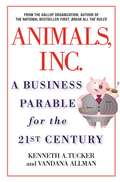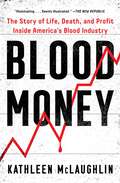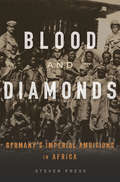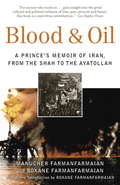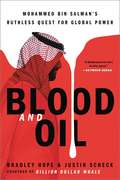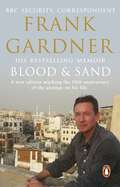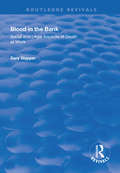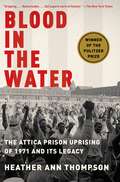- Table View
- List View
Blogging at BzzAgent
by David B. GodesBzzAgent is a word-of-mouth marketing firm. The founder, Dave Balter, sees blogs as an important way to communicate BzzAgent's unique positioning: transparency. He sees the firm's blog--the BeeLog--as a way for the firm to participate in conversations with clients, employees, and "agents." However, he has been unhappy with the level of interaction the blog has been generating, and is considering shutting it down. The case provides a context for a discussion about word of mouth marketing and social media, as well as about blogs specifically. It also provides examples of other corporate blogs, and allows for students to weigh the benefits and drawbacks of this potentially-important form of communication.
Blogging for Creatives: How Deisgners, Astists, Crafters And Writers Can Blog To Make Contacts, Win Business And Build Success
by Robin HoughtonBlogging for Creatives teaches you everything you need to know about how to design and profit from a beautiful blog that people will want to return to again and again. Complete with hundreds of tips, tricks and motivational stories from artistic bloggers who have started from scratch, Blogging for Creatives covers how to publish and host a blog, as well as keeping it fresh, staying motivated and forging connections. Whether you?re looking to create a platform for your creative trade, an inspirational journal, or a hub for people with similar tastes and interests, learn how to benefit from being part of the blogosphere in this accessible, non-techie guide.
Blogging in One Hour for Lawyers
by Ernie SevensonUntil a few years ago, only the largest firms could afford to engage an audience of millions. Now, lawyers in any size firm can reach a global audience at little to no cost—all because of blogs. An effective blog can help you promote your practice, become more "findable" online, and take charge of how you are perceived by clients, journalists and anyone who uses the Internet. Blogging in One Hour for Lawyers will show you how to create, maintain, and improve a legal blog—and gain new business opportunities along the way. In just one hour, you will learn to: • Set up a blog quickly and easily • Write blog posts that will attract clients • Choose from various hosting options like Blogger, TypePad, and WordPress • Make your blog friendly to search engines, increasing your ranking • Tweak the design of your blog by adding customized banners and colors • Easily send notice of your blog posts to Facebook and Twitter • Monitor your blog's traffic with Google Analytics and other tools • Avoid ethics problems that may result from having a legal blog
Blogging: El método moderno de comunicación masiva (Cómo hacer... #47)
by Owen JonesBlogging El método moderno de comunicación masiva Hola, El blogging, o “blogueo”, es el método moderno más barato de comunicación masiva, disponible para todos en cualquier lugar del mundo… sin importar el idioma que hables. Existen muchas plataformas que le permiten a la gente “bloguear” por un precio muy bajo o incluso gratis, o bien puedes establecer tu propia plataforma como un sitio web, y una vez que comienzas, puedes escribir acerca de casi cualquier cosa que quieras. El objetivo de este manual es el mostrarte cómo puedes comenzar el camino de convertirte en un “blogger”. Espero que la información en este manual resulte de ayuda, útil y rentable. La misma se refiere a varios aspectos del blogueo y a otras cuestiones relacionadas, y ha sido organizado en 17 capítulos de alrededor de 500-600 palabras cada uno. Espero que interesará a aquellos que gustan de, o les gustaría, escribir un diario y/o un blog, además de los administradores de sitios web que necesitan contenido para sus publicaciones online. Entonces, como bonus añadido, les entrego a ustedes permiso para utilizar el contenido en sus propios sitios web o en sus propios blogs y boletines de noticias virtuales, aunque será mejor si lo reescriben en sus propias palabras primero. También podrán dividir el libro y revender los artículos. De hecho, el único derecho que no tienen es el de revender o regular el libro tal como se les ha entregado. Si tienen alguna devolución o recomendación, por favor facilítenla a la compañía a la cual compraron este libro.
Blogging: La mejor pequeña guía para administrar un blog redituable
by Isaac KronenbergSeguro que ya has escuchado esto antes, sólo escoge el nicho apropiado, escribe buenos artículos, esparce vínculos de afiliación por todos lados, y obtendrás ganancias. Bueno, ¡tengo noticias para ti! ¡Eso NO es lo que hacen los blogueros que obtienen grandes ganancias! Aunque hay algo de cierto en el hecho de que parte de la ecuación es generar vínculos de afiliación para tu blog, sólo esparcirlos al azar y esperar que alguien de un cliqueo no es una buena estrategia en absoluto. Entonces, este libro se concentra en revelarte exactamente lo que los blogueros que obtienen grandes ganancias realmente hacen (que es lo que hago exactamente yo). No cometas errores, la mayoría que comienza un blog no tiene ni idea de cómo monetizarlo, y fallan en lograr que el blog sea redituable; esa es la realidad, tu competición es muy baja si haces las cosas bien, si haces lo que te indico en este libro. De hecho, no tendrás que leer otro libro sobre blogging nuevamente porque sabrás exactamente lo que tienes que hacer para monetizar tu blog. Confía en mí, este libro será el mejor libro sobre blogging que jamás hayas leído, y te mostrará un mapa muy real y directo para asegurarte que obtengas ganancias desde tu blog. La única manera de fracasar es no implementar el método que te enseñaré, así que asegúrate no sólo de leer este libro en forma pasiva sino realmente aplicando lo que te vaya indicando, ya que estoy absolutamente seguro de que logrará llevar tu blog a otro nivel.
Blogging: Obtén US$ 2000 al mes en 90 días
by Isaac Kronenberg¡Isaac Kronenberg lo logra de nuevo, otro libro fascinante sobre blogging que va más allá de cualquier otro libro que ya exista! Este último libro de Kronenberg es el libro sobre blogging más avanzado del mercado, enseñando nada más ni nada menos que las estrategias más efectivas de monetizar que existen para obtener un blog que genere de cero a US$2000 por mes en 90 días. Todo lo que está incluido en este libro está basado en estrategias reales utilizadas por blogueros que generan muchos ingresos en la actualidad. Ya sea que seas nuevo en el blogging o un bloguero avanzado, si existe una píldora mágica que puede llevarte de cero a generar un ingreso a tiempo completo de un blog, entonces este libro es el objeto más cercano que existe a esa píldora mágica. Si en serio te propones generar ingresos con el blogging, entonces este libro será el mejor libro que hayas leído acerca del tema.
Blogs at Dresdner Kleinwort Wasserstein: (A)
by Andrew Mcafee Anders SjomanIn May 2005, JP Rangaswami, the chief information officer at investment bank Dresdner Kleinwort Wasserstein (DrKW), wonders how to extend the bank's use of blogs. Corporations are now increasingly using these tools to diffuse news, opinions, and knowledge and improve collaboration. At DrKW, there are already over 300 internal blogs and Rangaswami now wants to encourage their internal spread. He has to make a compelling case for using blogs as well as make them easy to use. In addition, Rangaswami wants the bank to allow external blogs that others can view on the Internet. However, given the strict disclosure regulations that govern the bank's operations, Rangaswami wonders whether there are any safeguards that would help convince the bank's executive staff to allow external blogs.
Blonde Ambition: A Business Parable for the 21st Century (A-List Novel #6)
by Zoey DeanBlonde Ambition is the third novel in this witty and risqué series that takes readers behind the scenes of the intoxicating world of Hollywood glitterati. Upper East Side blueblood Anna Percy came to L.A. to learn how to have a good time. Then her new beau, Princeton prince Ben Birnbaum, and his amazing disappearing act turned out to be anything but. Anna finally begins to understand that telling true love from true lust is far more easily said than done. The fast times of Beverly Hills' most beautiful and glamorous people drive the page-turning action of this third novel in the bestselling A-List series. While Anna's new job as intern on the hottest television show brings her into contact with an interesting new man and helps her see how possessive Ben has become, Cammie sets her sights on Adam.
Blood Money: The Story of Life, Death, and Profit Inside America's Blood Industry
by Kathleen McLaughlinA &“haunting&” (Anne Helen Petersen, author of Can&’t Even) and deeply personal investigation of an underground for-profit medical industry and the American underclass it drains for blood and profit.Journalist Kathleen McLaughlin knew she&’d found a treatment that worked on her rare autoimmune disorder. She had no idea it had been drawn from the veins of America&’s most vulnerable. So begins McLaughlin&’s ten-year investigation researching and reporting on the $20-billion-a year business she found at the other end of her medication, revealing a &“vampiric real-life story of modern-day greed&” (Leah Sottile, host of Bundyville). Assigned to work in China, where the plasma supply had been rocked by numerous scandals, McLaughlin hid American plasma in her luggage during trips between the two countries. And when she was warned by a Chinese researcher of troubling echoes between America&’s domestic plasma supply chain and the one she&’d seen spin out into chaos in China, she knew she had to dig deeper. Blood Money shares McLaughlin&’s decade-long mission to learn the full story of where her medicine comes from. She travels the United States in search of the truth about human blood plasma and learns that twenty million Americans each year sell their plasma for profit—a human-derived commodity extracted inside our borders to be processed and packaged for retail across the globe. She investigates the thin evidence pharmaceutical companies have used to push plasma as a wonder drug for everything from COVID-19 to wrinkled skin. And she unearths an American economic crisis hidden in plain sight: single mothers, college students, laid-off Rust Belt auto workers, and a booming blood market at America&’s southern border, where collection agencies target Mexican citizens willing to cross over and sell their plasma for substandard pay. This &“captivating and anguished exposé&” (Publishers Weekly) weaves together McLaughlin&’s personal battle to overcome illness while also facing her own complicity in this wheel of exploitation with an electrifying portrait of big business run amok.
Blood On Steel: Chicago Steelworkers and the Strike of 1937 (Witness to History)
by Michael DennisThis historical analysis of the 1937 Chicago Steel Strike demonstrates how it revealed systemic oppression and inspired the larger progressive movement. On Memorial Day 1937, thousands of steelworkers and labor rights supporters gathered on the Southeast Side of Chicago to protest Republic Steel. By the end of the day, ten marchers had been mortally wounded and more than one hundred badly injured, victims of a terrifying police riot that came to be known as the Memorial Day Massacre. In Blood on Steel, historian Michael Dennis identifies this tragic landmark in the fight for labor rights as a focal point in the larger movement for American equality during the New Deal. Dennis shows how the riot—captured on film by Paramount newsreels—validated the claims of labor activists and catalyzed public opinion in their favor. Senate hearings about the massacre revealed patterns of anti-union aggression among management, ranging from blacklists to harassment and vigilante violence. The following year, Congress would pass the Fair Labor Standards Act. Dennis&’s wide-angle perspective reveals the Memorial Day Massacre as more than another bloody incident in the long story of American labor-management tensions. It was an all-too graphic illustration of the need for a broad-based social democracy movement.
Blood Runs Coal: The Yablonski Murders And The Battle For The United Mine Workers Of America
by Mark A. BradleyA vivid account of “one of the most shocking episodes in organized labor’s blood-soaked history” (Steve Halvonik, Pittsburgh Post-Gazette). In the early hours of New Year’s Eve 1969, in the small soft coal mining borough of Clarksville, Pennsylvania, longtime trade union insider Joseph “Jock” Yablonski and his wife and daughter were brutally murdered in their old stone farmhouse. Behind the assassination was the corrupt president of the United Mine Workers of America (UMWA), Tony Boyle, who had long embezzled UMWA funds, silenced intra-union dissent, and served the interests of Big Coal companies—and would do anything to maintain power. The most infamous crimes in the history of American labor unions, the Yablonski murders catalyzed the first successful rank-and-file takeover of a major labor union in modern US history. Blood Runs Coal is an extraordinary portrait of one of the nation’s major unions on the brink of historical change.
Blood and Diamonds: Germany's Imperial Ambitions in Africa
by Steven PressDiamonds have long been bloody. A new history shows how Germany’s ruthless African empire brought diamond rings to retail display cases in America—at the cost of African lives. Since the late 1990s, activists have campaigned to remove “conflict diamonds” from jewelry shops and department stores. But if the problem of conflict diamonds—gems extracted from war zones—has only recently generated attention, it is not a new one. Nor are conflict diamonds an exception in an otherwise honest industry. The modern diamond business, Steven Press shows, owes its origins to imperial wars and has never escaped its legacy of exploitation. In Blood and Diamonds, Press traces the interaction of the mass-market diamond and German colonial domination in Africa. Starting in the 1880s, Germans hunted for diamonds in Southwest Africa. In the decades that followed, Germans waged brutal wars to control the territory, culminating in the genocide of the Herero and Nama peoples and the unearthing of vast mineral riches. Press follows the trail of the diamonds from the sands of the Namib Desert to government ministries and corporate boardrooms in Berlin and London and on to the retail counters of New York and Chicago. As Africans working in terrifying conditions extracted unprecedented supplies of diamonds, European cartels maintained the illusion that the stones were scarce, propelling the nascent U.S. market for diamond engagement rings. Convinced by advertisers that diamonds were both valuable and romantically significant, American purchasers unwittingly funded German imperial ambitions into the era of the World Wars. Amid today’s global frenzy of mass consumption, Press’s history offers an unsettling reminder that cheap luxury often depends on an alliance between corporate power and state violence.
Blood and Fire: Toward a Global Anthropology of Labor
by Sharryn Kasmir August CarbonellaBased on long-term fieldwork, six vivid ethnographies from Colombia, India, Poland, Spain and the southern and northern U.S. address the dwindling importance of labor throughout the world. The contributors to this volume highlight the growing disconnect between labor struggles and the advancement of the greater common good, a phenomenon that has grown since the 1980s. The collection illustrates the defeat and unmaking of particular working classes, and it develops a comparative perspective on the uneven consequences of and reactions to this worldwide project. Blood and Fire charts a course within global anthropology to address the widespread precariousness and the prevalence of insecure and informal labor in the twenty-first century.
Blood and Money: War, Slavery, Finance, and Empire
by David McNallyThe history of money and its violent and oppressive origins from slavery to war—by the author of Global Slump. In most accounts of the origins of money we are offered pleasant tales in which it arises to the mutual benefit of all parties as a result of barter. But in this groundbreaking study, David McNally reveals the true story of money&’s origins and development as one of violence and human bondage. Money&’s emergence and its transformation are shown to be intimately connected to the buying and selling of slaves and the waging of war. Blood and Money demonstrates the ways that money has &“internalized&” its violent origins, making clear that it has become a concentrated force of social power and domination. Where Adam Smith observed that monetary wealth represents &“command over labor,&” this paradigm shifting book amends his view to define money as comprising the command over persons and their bodies.&“This fascinating and informative study, rich in novel insights, treats money not as an abstraction from its social base but as deeply embedded in its essential functions and origins in brutal violence and harsh oppression.&” —Noam Chomsky &“A fine-grained historical analysis of the interconnection between war, enslavement, finance, and money from classical times to present.&” —Jeff Noonan, author of The Troubles of Democracy &“McNally casts an unsparing light on the origins of money—and capitalism itself—in this scathing, Marxist-informed account . . . . McNally builds a powerful, richly documented argument that unchecked capitalism prioritizes greed and violence over compassion . . . . [T]his searing academic treatise makes a convincing case.&” —Publishers Weekly
Blood and Oil: A Prince's Memoir of Iran, from the Shah to the Ayatollah
by Manucher Farmanfarmaian Roxane FarmanfarmaianPEN/West Award Finalist. "Told with energy, perception and great charm. ... For anyone who wants to ... gain insight into the great cultural and political richness of Iran, past, present and future, this book is a marvelous introduction." --Fred Halliday, Los Angeles Times. Iran was the first country in the Middle East to develop an oil industry, and oil has been central to its tumultuous twentieth-century history.A finalist for the PEN/West Award, Blood and Oil tells the epic inside story of the battle for Iranian oil. A prominent member of one of Iran's most powerful aristocratic families--so feared by Khomeini that the entire clan was blacklisted--Prince Manucher Farmanfarmaian was raised in a harem at the heart of Iran's imperial court. With wit and provocative detail, he describes the days when he served as the Shah's oil adviser and pioneered the partnership that resulted in OPEC. Beautifully written and epic in its scope, this scintillating memoir provides a fascinating history of modern Iran. "Distinguished by its political acumen, historical sense, and vividness of description and anecdote. It is also notable for a wry sense of humour. ... Amid the euphoria about the development of the oilfields of Central Asia and the Transcaucasus, [its] lesson should be kept in mind." --Anatol Lieven, Financial Times. "A book of stunning beauty ... One of the best accounts of the cultural and political life of modern Iran, it is exquisite and intimate, rendered with artistry and detail." --Fouad Ajami.
Blood and Oil: Mohammed bin Salman's Ruthless Quest for Global Power
by Bradley Hope Justin Scheck**Longlisted for the Financial Times & McKinsey Business Book of the Year Award**From award-winning Wall Street Journal reporters Justin Scheck and Bradley Hope (coauthor of Billion Dollar Whale), this revelatory look at the world's most powerful ruling family reveals how a rift within Saudi Arabian royalty produced Crown Prince Mohammed bin Salman, a charismatic leader with a ruthless streak.Thirty-five-year-old Mohammed bin Salman's sudden rise stunned the world. Political and business leaders such as former UK prime minister Tony Blair and WME chairman Ari Emanuel flew out to meet with the crown prince and came away convinced that his desire to reform the kingdom was sincere. He spoke passionately about bringing women into the workforce and toning down Saudi Arabia's restrictive Islamic law. He lifted the ban on women driving and explored investments in Silicon Valley.But MBS began to betray an erratic interior beneath the polish laid on by scores of consultants and public relations experts like McKinsey & Company. The allegations of his extreme brutality and excess began to slip out, including that he ordered the assassination of Washington Post journalist Jamal Khashoggi. While stamping out dissent by holding three hundred people, including prominent members of the Saudi royal family, in the Ritz-Carlton hotel and elsewhere for months, he continued to exhibit his extreme wealth, including buying a $70 million chateau in Europe and one of the world's most expensive yachts. It seemed that he did not understand nor care about how the outside world would react to his displays of autocratic muscle-what mattered was the flex.Blood and Oil is a gripping work of investigative journalism about one of the world's most decisive and dangerous new leaders. Hope and Scheck show how MBS's precipitous rise coincided with the fraying of the simple bargain that had been at the head of U.S.-Saudi relations for more than eighty years: oil in exchange for military protection. Caught in his net are well-known US bankers, Hollywood figures, and politicians, all eager to help the charming and crafty crown prince.The Middle East is already a volatile region. Add to the mix an ambitious prince with extraordinary powers, hunger for lucre, a tight relationship with the White House through President Trump's son in law Jared Kushner, and an apparent willingness to break anything -- and anyone -- that gets in the way of his vision, and the stakes of his rise are bracing. If his bid fails, Saudi Arabia has the potential to become an unstable failed state and a magnet for Islamic extremists. And if his bid to transform his country succeeds, even in part, it will have reverberations around the world.
Blood and Sand: The BBC security correspondent’s own extraordinary and inspiring story
by Frank GardnerOn the June 6, 2004, while on assignment in Riyadh, BBC security correspondent Frank Gardner and cameraman Simon Cumbers were ambushed by Islamist gunmen. Simon was killed outright. Frank was hit in the shoulder and leg. As he lay in the dust, a figure stood over him and pumped four more bullets into his body at point-blank range...Against all the odds, Frank Gardner survived. Today, although partly paralysed, Frank continues to travel the world, reporting and making documentaries for the BBC. This acclaimed memoir was brought up to date with a new chapter that recounted his return to Saudi Arabia for the first time since he was shot and the story he tells continues to move and inspire, and remains an affirmation of his deep understanding of - and affection for - the Islamic world in these uncertain times.___'Gardner tells his remarkable tale well and bravely, with an astonishing lack of anger and enduring love and respect for the Islamic world' SUNDAY TIMES'Brave, unsentimental and genuinely inspiring' EVENING STANDARD 'What makes Gardner's moving, often humorous, deeply personal story so important is the fact that he has woven into it a brilliantly dispassionate, clear-eyed account of the Islamic world' SCOTSMAN'A witty, self-deprecating, inspiring testament' DAILY TELEGRAPH
Blood and Treasure: The Economics of Conflict from the Vikings to Ukraine
by Duncan WeldonBlood and Treasure is the story of the economics of conflict from the Viking Age to the war in Ukraine.'A brilliant book' MARTIN WOLF, FINANCIAL TIMES CHIEF ECONOMICS EDITOR'Chock full of marvellous nuggets, this fascinating book is both important and surprisingly cheering' ED CONWAY, author of Material WorldWars are expensive, both in human terms and monetary ones. But while warfare might be costly it has also, at times, been an important driver of economic change and progress. Over the long span of history nothing has shaped human institutions - and thus the process of economic development - as much as war and violence. Wars made states and states made wars. As the costs of warfighting grew so did state structures, taxation systems and national markets for debt. And as warfare became ever more destructive the incentive for governments to resort to it changed too. Blood and Treasure looks at the history and economics of warfare from the Viking Age to the war in Ukraine, examining how incentives and institutions have changed over time. It surveys how warfare may have driven Europe's rise to global prominence, and it explains how the total wars of the twentieth century required a new type of strategy, one that took economics seriously. Along the way it asks whether Genghis Khan should be regarded as the father of globalisation, explains how New World gold and silver kept Spain poor, ponders why some economists think of witch trials as a form of 'non-price competition', notes how pirate captains were pioneers of effective HR techniques, asks if handing out medals hurt the Luftwaffe in the Second World War and assesses if economic theories helped to create a tragedy in Vietnam. As well as considering why some medieval kings were right to arm their soldiers with inferior weapons, taking some management lessons from Joseph Stalin and asking if a culture of patronage and cronyism helped the Royal Navy rise to greatness.Underpinning it all is a focus on how and why the economics of conflict have changed over time. Economics can help to explain war and understanding the history of warfare can help explain modern economics.
Blood and Treasure: The Economics of Conflict from the Vikings to Ukraine
by Duncan WeldonBlood and Treasure is the story of the economics of conflict from the Viking Age to the war in Ukraine.'Absolutely fascinating and totally absorbing' JAMES HOLLAND'A brilliant book' MARTIN WOLF, FINANCIAL TIMES CHIEF ECONOMICS EDITOR'Chock full of marvellous nuggets, this fascinating book is both important and surprisingly cheering' ED CONWAY'A delightfully quirky approach to military history' SPECTATORWars are expensive, both in human terms and monetary ones. But while warfare might be costly it has also, at times, been an important driver of economic change and progress. Over the long span of history nothing has shaped human institutions - and thus the process of economic development - as much as war and violence. Wars made states and states made wars. As the costs of warfighting grew so did state structures, taxation systems and national markets for debt. And as warfare became ever more destructive the incentive for governments to resort to it changed too. Blood and Treasure looks at the history and economics of warfare from the Viking Age to the war in Ukraine, examining how incentives and institutions have changed over time. It surveys how warfare may have driven Europe's rise to global prominence, and it explains how the total wars of the twentieth century required a new type of strategy, one that took economics seriously. Along the way it asks whether Genghis Khan should be regarded as the father of globalisation, explains how New World gold and silver kept Spain poor, ponders why some economists think of witch trials as a form of 'non-price competition', notes how pirate captains were pioneers of effective HR techniques, asks if handing out medals hurt the Luftwaffe in the Second World War and assesses if economic theories helped to create a tragedy in Vietnam. As well as considering why some medieval kings were right to arm their soldiers with inferior weapons, taking some management lessons from Joseph Stalin and asking if a culture of patronage and cronyism helped the Royal Navy rise to greatness.Underpinning it all is a focus on how and why the economics of conflict have changed over time. Economics can help to explain war and understanding the history of warfare can help explain modern economics.
Blood and Treasure: The Economics of Conflict from the Vikings to Ukraine
by Duncan WeldonBlood and Treasure is the story of the economics of conflict from the Viking Age to the war in Ukraine.'Absolutely fascinating and totally absorbing' JAMES HOLLAND'A brilliant book' MARTIN WOLF, FINANCIAL TIMES CHIEF ECONOMICS EDITOR'Chock full of marvellous nuggets, this fascinating book is both important and surprisingly cheering' ED CONWAY'A delightfully quirky approach to military history' SPECTATORWars are expensive, both in human terms and monetary ones. But while warfare might be costly it has also, at times, been an important driver of economic change and progress. Over the long span of history nothing has shaped human institutions - and thus the process of economic development - as much as war and violence. Wars made states and states made wars. As the costs of warfighting grew so did state structures, taxation systems and national markets for debt. And as warfare became ever more destructive the incentive for governments to resort to it changed too. Blood and Treasure looks at the history and economics of warfare from the Viking Age to the war in Ukraine, examining how incentives and institutions have changed over time. It surveys how warfare may have driven Europe's rise to global prominence, and it explains how the total wars of the twentieth century required a new type of strategy, one that took economics seriously. Along the way it asks whether Genghis Khan should be regarded as the father of globalisation, explains how New World gold and silver kept Spain poor, ponders why some economists think of witch trials as a form of 'non-price competition', notes how pirate captains were pioneers of effective HR techniques, asks if handing out medals hurt the Luftwaffe in the Second World War and assesses if economic theories helped to create a tragedy in Vietnam. As well as considering why some medieval kings were right to arm their soldiers with inferior weapons, taking some management lessons from Joseph Stalin and asking if a culture of patronage and cronyism helped the Royal Navy rise to greatness.Underpinning it all is a focus on how and why the economics of conflict have changed over time. Economics can help to explain war and understanding the history of warfare can help explain modern economics.
Blood in the Bank: Social and Legal Aspects of Death at Work (Routledge Revivals)
by Gary SlapperFirst published in 1999, this volume is based upon a detailed empirical study of 40 cases of commercially-related deaths - the first such English study. The cases are taken from 20 towns and cities in England. Slapper critically examines the theory and practice of the legal response to such deaths. The conduct of the Health and Safety Executive, the police, coroner, lawyers and the Crown Prosecution Service are analyzed in detail. He executes his analysis in three stages: events are first scrutinized in the context of the law that governs them; the deaths and official responses are then considered in the context of the psychology of the decision-makers; and finally the dramas are looked at in a wider context of political economy. Slapper draws several disturbing conclusions. His original empirical research, based on attending coroner’s hearings and interviewing those interviewing those involved in enforcing safety laws, shows how and why potentially criminal behaviour at work is constructed as merely regulatory misbehaviour or even as no more than an unavoidable ‘accident’.
Blood in the Machine: The Origins of the Rebellion Against Big Tech
by Brian Merchant"The most important book to read about the AI boom" (Wired): The "gripping" (New Yorker) true story of the first time machines came for human jobs—and how the Luddite uprising explains the power, threat, and toll of big tech and AI today Named one of the best books of the year by The New Yorker, Wired, and the Financial Times • A Next Big Idea Book Club "Must-Read" The most urgent story in modern tech begins not in Silicon Valley but two hundred years ago in rural England, when workers known as the Luddites rose up rather than starve at the hands of factory owners who were using automated machines to erase their livelihoods. The Luddites organized guerrilla raids to smash those machines—on punishment of death—and won the support of Lord Byron, enraged the Prince Regent, and inspired the birth of science fiction. This all-but-forgotten class struggle brought nineteenth-century England to its knees. Today, technology imperils millions of jobs, robots are crowding factory floors, and artificial intelligence will soon pervade every aspect of our economy. How will this change the way we live? And what can we do about it? The answers lie in Blood in the Machine. Brian Merchant intertwines a lucid examination of our current age with the story of the Luddites, showing how automation changed our world—and is shaping our future.
Blood in the Water: The Attica Prison Uprising of 1971 and Its Legacy
by Heather Ann ThompsonNATIONAL BOOK AWARD FINALIST * NEW YORK TIMES NOTABLE BOOK FOR 2016 * NAMED A BEST BOOK OF THE YEAR BY THE BOSTON GLOBE, NEWSWEEK, KIRKUS, AND PUBLISHERS WEEKLYTHE FIRST DEFINITIVE HISTORY OF THE INFAMOUS 1971 ATTICA PRISON UPRISING, THE STATE’S VIOLENT RESPONSE, AND THE VICTIMS’ DECADES-LONG QUEST FOR JUSTICE On September 9, 1971, nearly 1,300 prisoners took over the Attica Correctional Facility in upstate New York to protest years of mistreatment. Holding guards and civilian employees hostage, the prisoners negotiated with officials for improved conditions during the four long days and nights that followed. On September 13, the state abruptly sent hundreds of heavily armed troopers and correction officers to retake the prison by force. Their gunfire killed thirty-nine men—hostages as well as prisoners—and severely wounded more than one hundred others. In the ensuing hours, weeks, and months, troopers and officers brutally retaliated against the prisoners. And, ultimately, New York State authorities prosecuted only the prisoners, never once bringing charges against the officials involved in the retaking and its aftermath and neglecting to provide support to the survivors and the families of the men who had been killed. Drawing from more than a decade of extensive research, historian Heather Ann Thompson sheds new light on every aspect of the uprising and its legacy, giving voice to all those who took part in this forty-five-year fight for justice: prisoners, former hostages, families of the victims, lawyers and judges, and state officials and members of law enforcement. Blood in the Water is the searing and indelible account of one of the most important civil rights stories of the last century.(With black-and-white photos throughout)
Blood in the Water: The Attica Prison Uprising of 1971 and Its Legacy
by Heather Ann ThompsonThe first definitive account of the infamous 1971 Attica prison uprising, the state's violent response, and the victims' decades-long quest for justice--including information never released to the public--published to coincide with the forty-fifth anniversary of this historic event.On September 9, 1971, nearly 1,300 prisoners took over the Attica Correctional Facility in upstate New York to protest years of mistreatment. Holding guards and civilian employees hostage, during the four long days and nights that followed, the inmates negotiated with state officials for improved living conditions. On September 13, the state abruptly ended talks and sent hundreds of heavily armed state troopers and corrections officers to retake the prison by force. In the ensuing gunfire, thirty-nine men were killed--hostages as well as prisoners--and close to one hundred were severely injured. After the prison was secured, troopers and officers brutally retaliated against the prisoners during the weeks that followed. For decades afterward, instead of charging any state employee who had committed murder or carried out egregious human rights abuses, New York officials prosecuted only the prisoners and failed to provide necessary support to the hostage survivors or the families of any of the men who'd been killed. Heather Ann Thompson sheds new light on one of the most important civil rights stories of the last century, exploring every aspect of the uprising and its legacy from the perspectives of all of those involved in this forty-five-year fight for justice: the prisoners, the state officials, the lawyers on both sides, the state troopers and corrections officers, and the families of the slain men. (With black-and-white illustrations throughout)"Superb . . . Gripping . . . Remarkable . . . Not all works of history have something to say so directly to the present, but Heather Ann Thompson's Blood in the Water: The Attica Prison Uprising of 1971 and Its Legacy, which deals with racial conflict, mass incarceration, police brutality and dissembling politicians, reads like it was special-ordered for the sweltering summer of 2016." --Mark Oppenheimer, The New York Times From the Hardcover edition.
Blood on Steel: Chicago Steelworkers and the Strike of 1937 (Witness to History)
by Michael DennisA pivotal moment in the history of the movement for working-class democracy, the "Memorial Day Massacre" vividly captured the conflicting ideals of workers’ rights and the sanctity of private property.On Memorial Day 1937, thousands of steelworkers, middle-class supporters, and working-class activists gathered at Sam's Place on the Southeast Side of Chicago to protest Republic Steel’s virulent opposition to union recognition and collective bargaining. By the end of the day, ten marchers had been mortally wounded and more than one hundred badly injured, victims of a terrifying police riot. Sam's Place, the headquarters for the steelworkers, was transformed into a bloody and frantic triage unit for treating heads split open by police batons, flesh torn by bullets, and limbs mangled badly enough to require amputation. While no one doubts the importance of the Memorial Day Massacre, Michael Dennis identifies it as a focal point in the larger effort to revitalize American equality during the New Deal. In Blood on Steel, Dennis shows how the incident—captured on film by Paramount newsreels—validated the claims of labor activists and catalyzed public opinion in their favor. In the aftermath of the massacre, Senate hearings laid bare patterns of anti-union aggression among management, ranging from blacklists to harassment and vigilante violence. Companies were determined to subvert the right to form a union, which Congress had finally recognized in 1935. Only in the following year would Congress pass the Fair Labor Standards Act, which established a minimum wage and a maximum work week, outlawed child labor, and regulated hazardous work. Like the Wagner Act that protected collective bargaining, this law aimed to protect workers who had suffered the worst of what the Great Depression had inflicted. Dennis‘s wide-angle perspective reveals the Memorial Day Massacre as not simply another bloody incident in the long story of labor-management tension in American history but as an illustration of the broad-based movement for social democracy which developed in the New Deal era.






